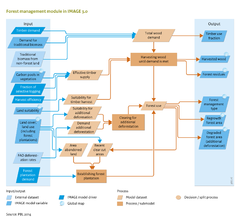Forest management: Difference between revisions
Jump to navigation
Jump to search
No edit summary |
No edit summary |
||
| Line 2: | Line 2: | ||
|IMAGEComponent=Scenario drivers; Agricultural systems; Natural vegetation and carbon cycle | |IMAGEComponent=Scenario drivers; Agricultural systems; Natural vegetation and carbon cycle | ||
|KeyReference=Arets et al, 2011 | |KeyReference=Arets et al, 2011 | ||
|InputVar=Timber demand; Demand for traditional biomass; Fraction of traditional biomass coming from non-forested land | |InputVar=Timber demand; Demand for traditional biomass; Fraction of traditional biomass coming from non-forested land; Fraction selective cut;; Harvest efficiency; Suitability; Land cover, land use - grid; | ||
FAO deforestation rates; Demand for Forest plantations; | FAO deforestation rates; Demand for Forest plantations; Carbon pools in vegetation, soil and timber - grid; | ||
|OutputVar=Timber use fraction; Harvested wood, divided over the 3 timber types - grid; Forest residues that remain in forest grid; Forest management type - grid; Area Regrowth forest - grid; Area degraded forest -grid | |OutputVar=Timber use fraction; Harvested wood, divided over the 3 timber types - grid; Forest residues that remain in forest grid; Forest management type - grid; Area Regrowth forest - grid; Area degraded forest -grid | ||
|Description==== Global context === | |Description==== Global context === | ||
| Line 20: | Line 20: | ||
The second type is that of selective logging, in which only the trees with the highest economic value are felled. This is more common in tropical forests with a high heterogeneity of tree species. Reduced impact logging (RIL) is an ecological variant of selective logging, to reduce harvest damage, stimulate regrowth and maintain biodiversity levels (Putz et al., 2012). As such, the RIL system is a more ecological and sustainable forest management system, which is promoted under SFM schemes. | The second type is that of selective logging, in which only the trees with the highest economic value are felled. This is more common in tropical forests with a high heterogeneity of tree species. Reduced impact logging (RIL) is an ecological variant of selective logging, to reduce harvest damage, stimulate regrowth and maintain biodiversity levels (Putz et al., 2012). As such, the RIL system is a more ecological and sustainable forest management system, which is promoted under SFM schemes. | ||
The third system is that of forest plantations, such as hardwoodtree plantations in the tropics and poplar plantations in temperate regions. Selected tree species, either endemic or exotic to the area, are planted and managed more intensively – for example, through irrigation and fertilizer use – to maximise production and/or wood quality. After the trees are harvested, new ones are planted, and management is put in place. Forest plantations generally have a high productivity level (Del Lungo et al., 2006). By producing more wood and wood products on less land, plantations may contribute to more sustainable forest management by reducing the pressures on natural forests (Carle and Homgren, 2008; Alkemade et al., 2009). At the same time, the ecological value of biodiversity in many forest plantations is relatively low (Hartman et al., 2010). | The third system is that of forest plantations, such as hardwoodtree plantations in the tropics and poplar plantations in temperate regions. Selected tree species, either endemic or exotic to the area, are planted and managed more intensively – for example, through irrigation and fertilizer use – to maximise production and/or wood quality. After the trees are harvested, new ones are planted, and management is put in place. Forest plantations generally have a high productivity level (Del Lungo et al., 2006). By producing more wood and wood products on less land, plantations may contribute to more sustainable forest management by reducing the pressures on natural forests (Carle and Homgren, 2008; Alkemade et al., 2009). At the same time, the ecological value of biodiversity in many forest plantations is relatively low (Hartman et al., 2010). | ||
|ComponentCode=FM | |ComponentCode=FM | ||
|AggregatedComponent=Agriculture and land use | |AggregatedComponent=Agriculture and land use | ||
|FrameworkElementType=pressure component | |FrameworkElementType=pressure component | ||
}} | }} | ||
Revision as of 17:28, 25 March 2014
Parts of Forest management
| Component is implemented in: |
| Components: |
| Related IMAGE components |
| Projects/Applications |
| Key publications |
| References |
Key policy issues
- How can management influence forest capacity to meet future demand for wood and other ecosystem services?
- What are the implications of forest management for pristine and managed forest areas, and on biomass and carbon stocks and fluxes of relevance for climate policy?
- What are the prospects for more sustainable forest management and the role of production in dedicated forest plantations?
